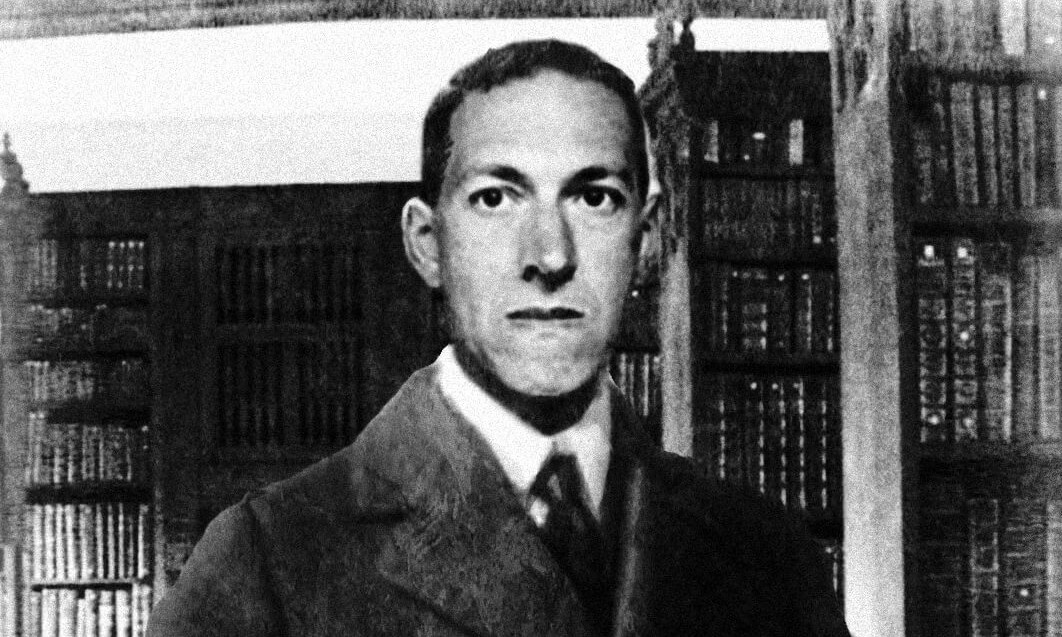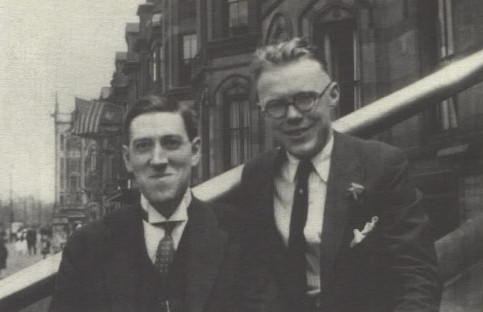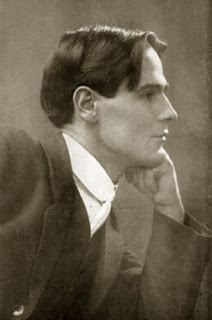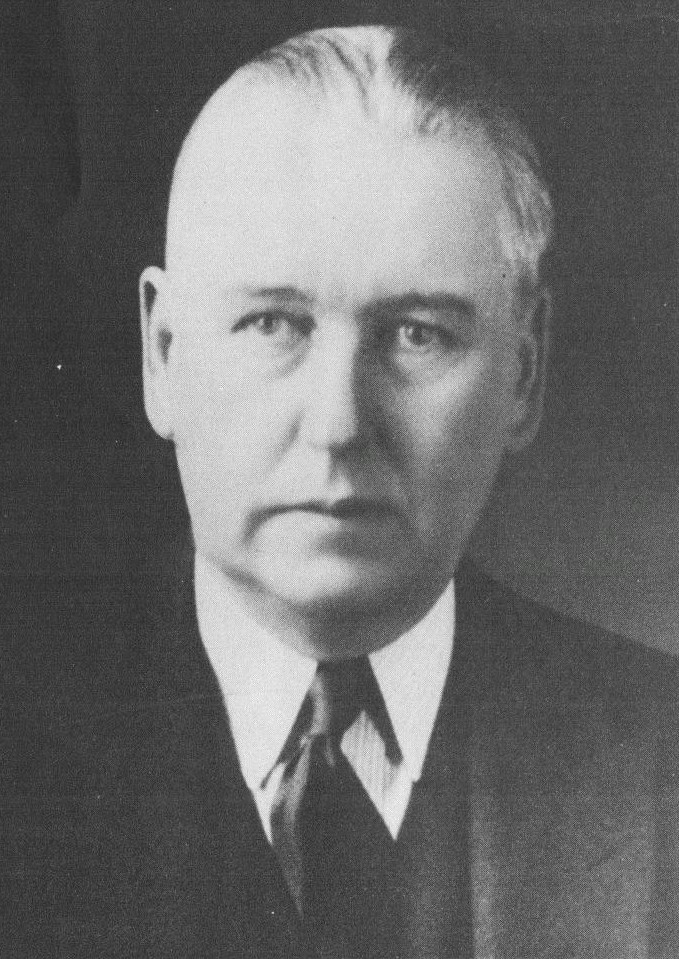
In celebration of the 125th anniversary of Howard Phillips Lovecraft’s birth, many fans will tonight drink a toast to the remarkable man from Providence, and most likely that’ll include the rereading of a story, or two, or three. For those more cinematically inclined it could mean viewing the 1963 movie The Haunted Palace, or Die Monster, Die! from 1965. If you like Lovecraft with a little more blood there’s always Stuart Gordon’s Dagon from 2001, or—well, the list is seemingly close to endless when it comes to film adaptations of Lovecraft’s work. There’s even something for old radio fans—Suspense, from 1945, brought us HPL’s “The Dunwich Horror,” starring Ronald Colman, and of course, more recently, there are many other radio plays being produced, most notably from the HPL Historical Society.
Perhaps best of all, when some fan drinks his toast of wine tonight he can extend his pinky finger and dig into the Library of America’s volume devoted to Lovecraft, and realize that his favorite author has become academically accepted. No longer will his memories be troubled by the sneers of high school teachers or college professors who questioned his choice of reading material. He feels justly vindicated and so this particular follower will refill his glass.
After he’s had too much to drink and the pages have become blurry, this slightly inebriated fan can then retire to his bed, clutching his Cthulhu plush toy for safety should the night-gaunts invade his dreams. He feels tomorrow could be a big day. He’ll read his fortune in the morning using his Lovecraft Tarot cards and then later that afternoon place his new HPL decals on his vehicle. He pulls off his Necronomicon T-shirt and crawls into bed, finally falling asleep, with the moonlight eerily illuminating the bust of Lovecraft that sits upon his computer desk.
It is truly a fact that H. P. Lovecraft is everywhere. His influence does extend beyond literature and he’s become a merchandise bonanza for various Internet sellers. All the items listed above are available for purchase by the fanatic fan, and there’s still more—including trading cards, comic books and even dresses for the ladies bearing the likeness of the dreaded Cthulhu, tentacles and all. While it’s great that this savvy marketing is spreading the fame of Lovecraft and his creations around the globe, it can perhaps sometimes draw our attention away from the man.
Today there will be quite a few bloggers sharing their experiences of when they first encountered Lovecraft through his fiction, and many of these writers will stress the significance of Lovecraft’s influence—from pulp authors such as Robert E. Howard to newer scribes such as Stanley C. Sargent, Lovecraft’s mythic world has been expanded, and it is only going to get bigger. No doubt many bloggers will bemoan, or laud, the new literary disciples that have stepped into the Lovecraft arena and that’s great, but I thought that today called for something a bit different and so I turned to the Arkham House volumes, Howard Phillips Lovecraft: Dreamer on the Nightside by Frank Belknap Long, and Lovecraft Remembered, edited by Peter Cannon. The last named volume is especially pertinent, because today is all about remembering Lovecraft, and most of the material presented here will have come from Cannon’s information-packed collector’s item.
But we’ll begin with Belknap Long and his slim volume of memories. As I stated earlier, lots of fans will be reading their favorite Lovecraft story tonight and that will most certainly include “At the Mountains of Madness.” In Dreamer on the Nightside, Belknapius (as Lovecraft fondly called him) relates the first, and only, time Lovecraft embarked on an airplane ride and, if you remember your “Mountains” you’ll also recollect that airplanes played a significant role in the short novel. Long writes he was with HPL in Cape Cod and that he remembers his older friend “wading out to a ramshackle, barnstorming type hydroplane” soon to be lost to sight on “a ten minute, harbor-encircling journey at the bargain price of two dollars.” Muriel Eddy, wife of “The Loved Dead” author C. M. Eddy, Jr., in “The Gentleman From Angell Street” tells us HPL once told her it was cheaper to buy a box of broken crackers rather than a box of whole crackers so it has to be assumed that two dollars was an enormous extravagance for a man who, worrying about saving perhaps a few cents, would take the box of busted crackers to the counter.
 W. Paul Cook in his “In Memoriam: Howard Phillips Lovecraft” relates how he once chided HPL on how little he spent on food—“After one of his trips—I think the one to New Orleans—I accused him of having an expense account something like this: Bus fare, $45.00; Food, $5.00; Postcards, $125.00.” Cook’s take on Lovecraft’s “expense account” is interesting, especially when considering the following story, also taken from Belknap Long’s Arkham book. Long details an amusing shopping trip he took with his pal near Battery Park and what occurred when Lovecraft decided he needed a new pen, which I’m certain cost more than crackers and cheese.
W. Paul Cook in his “In Memoriam: Howard Phillips Lovecraft” relates how he once chided HPL on how little he spent on food—“After one of his trips—I think the one to New Orleans—I accused him of having an expense account something like this: Bus fare, $45.00; Food, $5.00; Postcards, $125.00.” Cook’s take on Lovecraft’s “expense account” is interesting, especially when considering the following story, also taken from Belknap Long’s Arkham book. Long details an amusing shopping trip he took with his pal near Battery Park and what occurred when Lovecraft decided he needed a new pen, which I’m certain cost more than crackers and cheese.
It seemed that only a black Waterman pen would do for the typewriter-hating horror writer, and he told Long that he “intended to purchase a new pen at the first stationery store that had a well-stocked, reliable appearance.” Finding the right store after “three or four blocks” Long went inside with HPL. He writes “the clerk who waited on him was amiable and greeted him with a smile when he asked to try out a number of pens.” Lovecraft told the clerk the point needed to be just perfect and asked if he could test out about twenty pens. He informed Long that this could take a little time and so Long said he’d go check out some pipes and would be back in twenty minutes or so. After being away for closer to forty-five minutes Belknap writes that he returned to the stationery store to find the clerk had now spread out about fifty pens and that his friend was still having difficulty deciding which one would do.
It’s evident from this story that Lovecraft took his writing very seriously and while I find this to be one of Long’s more interesting recollections, I still have to feel sorry for the poor clerk and admire his patience.
Winfield Townley Scott’s essay “His Own Most Fantastic Creation” is extremely helpful in putting together a picture of Lovecraft and his times. He never met the man from Providence but Scott lived “an hour’s walk” from “the four houses Howard Phillips Lovecraft lived most of his life in.” While the entire article is full of great tidbits the most interesting point I found was that Lovecraft once presented a copy of George Gissing’s The Private Papers of Henry Ryecroft to Sonia Greene, evidently before their ill-fated marriage. Gissing’s book is a neglected masterpiece and deals with life, love, politics, and most importantly, the joy of collecting and reading books. Sonia revealed “that Lovecraft made a sort of Bible out of George Gissing’s book” and Scott feels that HPL may have “found in the book a sympathetic portrayal of personality startlingly like his own.” Scott addresses some similarities between the two men—“Ryecroft, for instance, loves to walk; he loves old books, even the scent of old books, and he dwells on how often in his youth he went hungry to buy them.” Further, “he hugs his solitude” and “loves his England” longing for the past and Ryecroft states that men such as him live and will die alone. It’s a great book even without the Lovecraft connection. One more interesting tidbit about Gissing—some Ripperologists have considered the writer as a possible Jack the Ripper candidate, which, of course, is just ludicrous.
And, since I brought up book-collecting, it’s worth noting that Winfield Scott adds that he has in his possession two books from Lovecraft’s library—Sarah Helen Whitman’s Poems, and as if that wasn’t enough, he further notes he has the horror writer’s copy of Dracula.
Every Lovecraft fan worth his “essential Saltes” knows that HPL collaborated with magician Harry Houdini on “Imprisoned with the Pharaohs.” Mrs. Eddy, in her memoir, states that her husband engaged in Spiritualism research for the great escapologist and that when Houdini played Providence for the last time Lovecraft went with her and her husband, making up a little “theatre party.” After the show Houdini took the group “to lunch at a Waldorf restaurant” around midnight. Beatrice, the wife of the famed performer, sat at table with her pet parrot, Lori, “perched demurely on her shoulder.” Mrs. Eddy writes that HPL “got quite a kick” watching the bird “sip tea from a spoon and nibble daintily at toast held” by Beatrice. She adds that Lovecraft “ordered half a cantaloupe filled with vanilla ice cream, and a cup of coffee.” It must have been a special night for the fantasy writer—“He was in great spirits and bubbled over with good humor, talking a blue streak about everything under the sun.” All this, Mrs. Eddy writes, while “Harry Houdini gazed at him admiringly.”
 Lovecraft’s night would probably have been even more special had he known that Houdini and William Hope Hodgson, the great horror writer from England, had crossed paths in 1902. In the Hodgson collection Out of the Storm, editor Sam Moskowitz states that at 22, Hodgson was “one of the most splendid physical specimens in the world” and operated W. H. Hodgson’s School of Physical Culture in Blackburn, England, where he evidently turned weaklings into men who would no longer tolerate having sand kicked in their face. So when Houdini came to town, offering $125 to anyone who could produce handcuffs or chains from which he could not release himself, Hodgson showed up, hoping to win the bet. Moskowitz tells us “Hodgson, who had an implicit knowledge of the interaction of muscles, scientifically latched Houdini in a manner which would give him the minimal play of sinew.” This must have irritated Houdini because he wondered aloud if the body-builder was trying to break his arms. After two hours Houdini finally extricated himself but “asserted that Hodgson’s treatment of him was the cruelest he had ever experienced.”
Lovecraft’s night would probably have been even more special had he known that Houdini and William Hope Hodgson, the great horror writer from England, had crossed paths in 1902. In the Hodgson collection Out of the Storm, editor Sam Moskowitz states that at 22, Hodgson was “one of the most splendid physical specimens in the world” and operated W. H. Hodgson’s School of Physical Culture in Blackburn, England, where he evidently turned weaklings into men who would no longer tolerate having sand kicked in their face. So when Houdini came to town, offering $125 to anyone who could produce handcuffs or chains from which he could not release himself, Hodgson showed up, hoping to win the bet. Moskowitz tells us “Hodgson, who had an implicit knowledge of the interaction of muscles, scientifically latched Houdini in a manner which would give him the minimal play of sinew.” This must have irritated Houdini because he wondered aloud if the body-builder was trying to break his arms. After two hours Houdini finally extricated himself but “asserted that Hodgson’s treatment of him was the cruelest he had ever experienced.”
While this is a bit of a digression from our look at Lovecraft it might have made for an interesting conversation the night Houdini and Lovecraft were at the Waldorf. Houdini was dead eight years before Lovecraft started reading Hodgson so there was simply no way for either to have known of the Hodgson connection, which is probably just as well—obviously Houdini would have been no fan of the author of The House on the Borderland.
Mrs. Eddy’s article is a very interesting one, containing much more than just her memories of the night they formed a dinner group with Houdini. After Lovecraft left Providence to get married in New York Mrs. Eddy received a letter from one of HPL’s aunts, Mrs. Gamwell. The Eddy family was invited to “call upon her as soon as possible” because she wished to give them “some of her nephew’s possessions, now that he was married and no longer needed them.” Mrs. Eddy continues, “The aunts then showed us the Murphy bed H.P.L. had slept in, and asked us if we could use it. Also, she offered us a marble-topped bureau, and countless books.” In short, the aunts loaded them down with so many items that “An expressman had to be engaged to haul” the whole lot to the Eddy family home. Mrs. Eddy continues, remembering “Mrs. Gamwell also gave the children about a hundred picture postcards that Sonia had mailed to Howard.” Sadly Mrs. Eddy writes “Not knowing their possible value in the far-away future, I did not hold on to any of these cards” and “they eventually went the way all children’s toys go…in the ash-heap!” Sad news, indeed!
 More sad news arises when we take a look at E. A. Edkins, who, as Peter Cannon puts it, “never met Lovecraft face to face, yet was one of his few correspondents whose letters [Lovecraft] valued enough to keep.” In Edkins’ article, “Idiosyncrasies of H.P.L.” he writes “All but one or two of the considerable number of letters that I received from him have been either lost or passed on to others, but I have a keen recollection of their archaic urbanity and charm.” Cannon adds that in a letter to J. Vernon Shea Lovecraft showed high regard for Edkins, writing that his correspondent was “a splendidly witty and civilized character, with fine aesthetic appreciations…”—it’s too bad those “aesthetic appreciations” didn’t help Edkins to recognize the future scholarly value of his correspondence, causing him to hang onto HPL’s letters.
More sad news arises when we take a look at E. A. Edkins, who, as Peter Cannon puts it, “never met Lovecraft face to face, yet was one of his few correspondents whose letters [Lovecraft] valued enough to keep.” In Edkins’ article, “Idiosyncrasies of H.P.L.” he writes “All but one or two of the considerable number of letters that I received from him have been either lost or passed on to others, but I have a keen recollection of their archaic urbanity and charm.” Cannon adds that in a letter to J. Vernon Shea Lovecraft showed high regard for Edkins, writing that his correspondent was “a splendidly witty and civilized character, with fine aesthetic appreciations…”—it’s too bad those “aesthetic appreciations” didn’t help Edkins to recognize the future scholarly value of his correspondence, causing him to hang onto HPL’s letters.
Lovecraftian neighbor Marian F. Bonner provides one of my favorite looks at the great author in her “Miscellaneous Impressions of H.P.L.,” once again from Peter Cannon’s book. This lucky lady got to spend a Christmas with Lovecraft and Mrs. Gamwell, writing “I can clearly remember the three of us sitting around their tiny Christmas tree.” It would have been pretty cool to have watched Lovecraft, an atheist, enjoy Christmas with his aunt. For me it’s a poignant moment, and it would be great if Ms. Bonner would have given more of the details of this particular Christmas, but except for mentioning she had a gift for the aunt—that Lovecraft helped her “smuggle” in—that’s about it.
So I guess that’s a good place to leave HPL, sitting in a warm house, probably drinking a cup of coffee loaded with sugar, safe from the horrors of the frigid weather outside.
I have only referenced a few of the recollections anthologized in these two Arkham House books; there are many, many more and all of them are interesting and well worth investigating on this, Lovecraft’s Day. And after reading some of these memories of Lovecraft there’ll still be time enough to dip into a good chilling story, and one of the best at providing that, is, of course, HPL.
For myself, I’ll read some Lovecraft yarn tonight, not sure which one yet, but once I make my choice I’ll ease into my favorite reading chair and let HPL take me on a terrifying journey while I enjoy every minute of it.
Now if I can just teach my dog to fetch my Cthulhu plush slippers.
